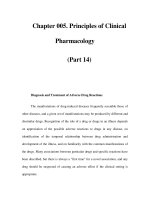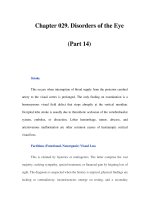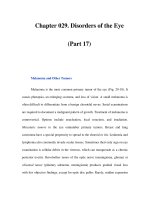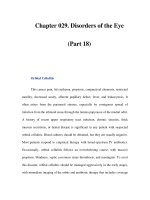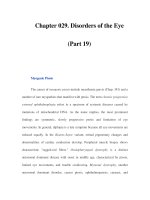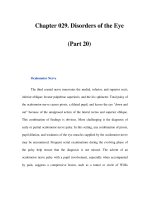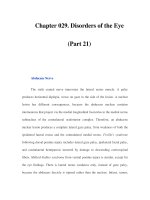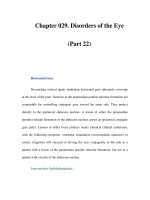Chapter 029. Disorders of the Eye (Part 14) pps
Bạn đang xem bản rút gọn của tài liệu. Xem và tải ngay bản đầy đủ của tài liệu tại đây (30.45 KB, 5 trang )
Chapter 029. Disorders of the Eye
(Part 14)
Stroke
This occurs when interruption of blood supply from the posterior cerebral
artery to the visual cortex is prolonged. The only finding on examination is a
homonymous visual field defect that stops abruptly at the vertical meridian.
Occipital lobe stroke is usually due to thrombotic occlusion of the vertebrobasilar
system, embolus, or dissection. Lobar hemorrhage, tumor, abscess, and
arteriovenous malformation are other common causes of hemianopic cortical
visual loss.
Factitious (Functional, Nonorganic) Visual Loss
This is claimed by hysterics or malingerers. The latter comprise the vast
majority, seeking sympathy, special treatment, or financial gain by feigning loss of
sight. The diagnosis is suspected when the history is atypical, physical findings are
lacking or contradictory, inconsistencies emerge on testing, and a secondary
motive can be identified. In our litigious society, the fraudulent pursuit of
recompense has spawned an epidemic of factitious visual loss.
Chronic Visual Loss
Cataract
This is a clouding of the lens sufficient to reduce vision. Most cataracts
develop slowly as a result of aging, leading to gradual impairment of vision. The
formation of cataract occurs more rapidly in patients with a history of ocular
trauma, uveitis, or diabetes mellitus. Cataracts are acquired in a variety of genetic
diseases, such as myotonic dystrophy, neurofibromatosis type 2, and galactosemia.
Radiation therapy and glucocorticoid treatment can induce cataract as a side effect.
The cataracts associated with radiation or glucocorticoids have a typical posterior
subcapsular location. Cataract can be detected by noting an impaired red reflex
when viewing light reflected from the fundus with an ophthalmoscope or by
examining the dilated eye using the slit lamp.
The only treatment for cataract is surgical extraction of the opacified lens.
Over a million cataract operations are performed each year in the United States.
The operation is generally done under local anesthesia on an outpatient basis. A
plastic or silicone intraocular lens is placed within the empty lens capsule in the
posterior chamber, substituting for the natural lens and leading to rapid recovery
of sight. More than 95% of patients who undergo cataract extraction can expect an
improvement in vision. In some patients, the lens capsule remaining in the eye
after cataract extraction eventually turns cloudy, causing secondary loss of vision.
A small opening is made in the lens capsule with a laser to restore clarity.
Glaucoma
This is a slowly progressive, insidious optic neuropathy, usually associated
with chronic elevation of intraocular pressure. In Americans of African descent it
is the leading cause of blindness.
The mechanism whereby raised intraocular pressure injures the optic nerve
is not understood. Axons entering the inferotemporal and superotemporal aspects
of the optic disc are damaged first, producing typical nerve fiber bundle or arcuate
scotomas on perimetric testing.
As fibers are destroyed, the neural rim of the optic disc shrinks and the
physiologic cup within the optic disc enlarges (Fig. 29-15). This process is
referred to as pathologic "cupping."
The cup-to-disc diameter is expressed as a ratio, e.g., 0.2/1. The cup-to-disc
ratio ranges widely in normal individuals, making it difficult to diagnose glaucoma
reliably simply by observing an unusually large or deep optic cup. Careful
documentation of serial examinations is helpful. In the patient with physiologic
cupping, the large cup remains stable, whereas in the patient with glaucoma it
expands relentlessly over the years. Detection of visual field loss by computerized
perimetry also contributes to the diagnosis. Finally, most patients with glaucoma
have raised intraocular pressure. However, many patients with typical
glaucomatous cupping and visual field loss have intraocular pressures that
apparently never exceed the normal limit of 20 mmHg (so-called low-tension
glaucoma).
Figure 29-15
